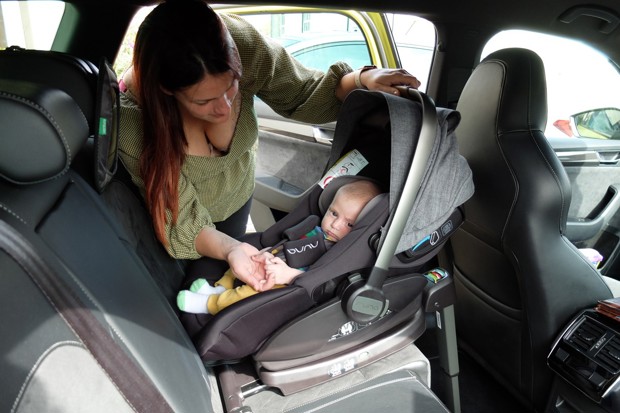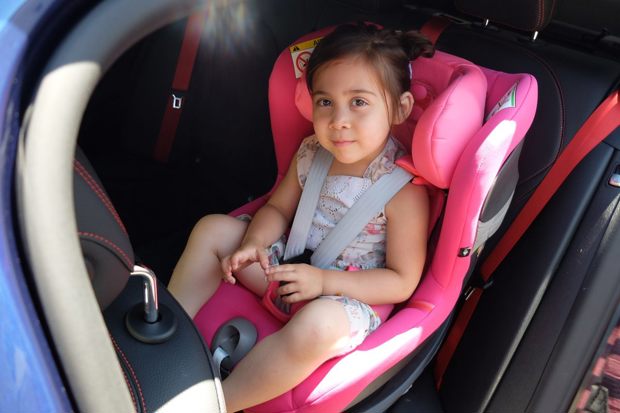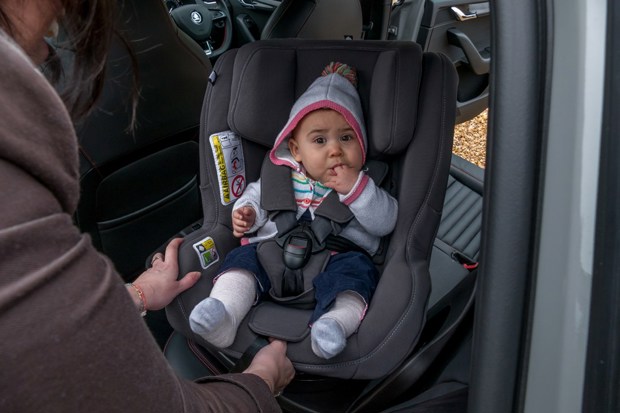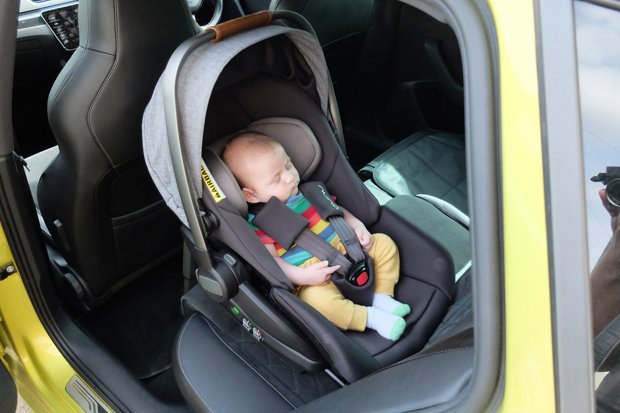Car child seat safety: Your complete guide
Children are the most precious cargo carried in cars, so their safety is paramount, but with various laws and standards to comply with, it's confusing. Here's everything you need to know.

- The law on child and booster seats
- Dos and don'ts when buying one
- Child seat-related jargon deciphered
Few sights generate concern, fear and anger in other drivers than seeing a child clambering around in a moving car.
While choosing a safe family car is important - how your children travel in that car is paramount. Kids are some of the most vulnerable members of society, so its adults' responsibility to ensure their welfare, including that they are as safe as possible when travelling in cars.
Rightly, the legal duty of care for children in cars is with the driver, regardless of whether or not they are the parent or guardian.
What doesn't help people do the right thing is the wide array of laws and standards relating to both the seat types and the ages or heights of the children they are intended for. Because kids aren't one-size-fits-all, the legal position can't be either, but here we've simplified the complexities without diluting the key elements you must know.
What do different car child seat groups mean?
The range of car seats on sale can be overwhelming but understanding the different groups plus what ages and weights they are designed for makes things a lot easier:
Group 0
Weight range: up to 10kg (22lb)
Age range: birth to nine months
Group 0+
Weight range: up to 13kg (29lb)
Age range: birth to 15 months
Group 0+/1
Weight range: up to 18kg (40lb)
Age range: birth to four years
Group 1
Weight range: 9-18kg (20-40lb)
Age range: nine months to four years
Group 2/3
Weight range: 15-36kg (33-79lb / 2st 5lb-5st 9lb)
Age range: three to 12 years
Group 3
Weight range: 22-36kg (49-79lb / 3st 7lb-5st 9lb)
Age range: six to 12 years
What are the main laws regarding car child seats?
Legally the position is crystal clear: child seats must be used from birth through to either the youngster's 12th birthday or they have grown to 135cm tall, whichever happens soonest. Beyond that they must wear a seatbelt like all other passengers.
Infants up to three-years-old, secured within the correct type of child seat, can be positioned in the front or rear, as per the driver's preference.
From three to 12 (or reaching 135cm tall), children should be again using the correct seat type, but sat in the rear. Sitting in the front is permissible where there are no rear seatbelts or if the rear seats are inaccessible or don't exist at all.
Some older SUVs, minibuses and camper vans have side-facing seats in the rear. These are not considered safe to attach child seats to, therefore using them to transport a child under 12 (or shorter than 135cm) is illegal.
There are some legal exceptions but we would advise against all of them — an unrestrained child could die as a result of an impact as slow as 5mph.
Children aged three or over can travel in the back of a car where there is no seatbelt or Isofix fitting to secure a child seat to. Typically, this would be for classic cars originally sold before rear seatbelts became a mandatory fitting in 1986.
If a journey is deemed to be in exceptional circumstances — that's to say it was necessary, unexpected, only for a short distance and where an appropriate child seat was unavailable — children aged three or over can travel in a car providing they are restrained as well as possible with the standard adult seatbelt.
Providing those same requirements are met, travelling in a taxi would also be legally regarded as an exceptional circumstance.

What to do before fitting a child seat
Before strapping a child into the car, it's vital you understand how the seat is intended to be fitted for the highest possible levels of safety:
- Does the seat have Isofix attachments? If it does but the car you were intending to fit it to does not have the necessary mounting points, ensure that you check whether it can be used with just a seatbelt instead.
- What type of seatbelts can be used? The vast majority of child seats can be used only with the additional security offered by three-point seatbelts. These are the type where the belt cross your lap horizontally and you chest diagnonally. Older cars with lap-only seatbelts, usually fitted to the centre-rear position, are rarely stated as being appropriate for child seats.
If you intend to fit a rear-facing seat for an infant in the front seat, it is vital that the passenger-side airbag is turned off. A rapidly inflating airbag can cause fatal injuries to babies and toddlers even if the impact itself did not.
Car Seat Chooser
Choosing - and buying - a car seat for your baby or child is a pain. It means visiting every child seat manufacturer - either online or in-store - to see if their seat fits your car and, if it does, it goes where you want it to. So we decided to do something about it. We built a car seat choosing tool that starts with the most important thing (well, after your child, that is): your car.
Tell us what car you have, or plan to get, and we will show you those that fit your car.
What is i-Size?
Child seats must conform to one of three European standards, the latest of which is i-Size.
These i-Size regulations are designed to give extra protection to children, with improved head and neck support along with additional protection in the event of frontal and side-on collisions.
Alongside that, all i-Size child seats have five-point harnesses to keep the youngster safely strapped in, even if the car rolls over.
Another key improvement is that rather than being categorised by the child’s age and weight, i-Size seats are classified by height, which makes sense given kids all grow at different rates.
All new cars, vans and pickups now have to be i-Size-compliant in order to achieve the maximum five-star Euro NCAP safety rating. All i-Size-compliant child seats will fit every i-Size-approved vehicle.
As a parent, you’re not breaking any law by not using an i-Size child seat. It’s a regulation aimed at car seat manufacturers to make it safer for children when travelling.
However, if you are looking for a new seat it’s certainly a good idea to go for an i-Size-compliant one. Most of the popular seats are already i-Size or are in the process of being redesigned to meet the latest regulations.
i-Size regulations on forward- and rear-facing seats
The latest i-Size regulations state that children must be rearward-facing until at they are at least 15 months old.
It's worth noting that most experts — including the British Medical Journal (BMJ) — suggest that it’s far safer for children to stay rear-facing until they are four-years-old, something we certainly recommend.
Of course that's dependant on the child and you know yours better than anyone else. Some youngsters are quite happy to face backwards but others may suffer from travel sickness or be perpetually grizzly if not sat facing forwards, which can be dangerously distracting for drivers.
Nowadays there are plenty of 360-degree swivelling and converting child seats available allowing you to switch whenever you wish.

Which seat is best for my child?
To make sure you know if your child is in the right seat you'll need to grab a tape measure and some weighing scales.
Once you've determined their height and weight — we'll assume you're fine remembering their dates of birth — you can then determine which type of seat they need.
Is my child's age not important?
Age ranges are approximate, meaning it’s their height and weight that really matter. You’ll also notice that the weight ranges of the seat groups cross over, but it’s always safer to keep a child in the lower group for as long as possible. A child in a seat that's too big isn't as safe as they would be in a smaller one.
It’s also possible to buy ‘1/2/3 group’ seats, which cover the entire spectrum, adjustable to convert from a baby seat into a booster, as well as the i-Size setup that covers from birth to around four years old.
Key points you need to know about booster seats
In 2017 the law on booster seats changed meaning their manufacturers were no longer allowed to introduce new backless versions for children under 125cm tall or weighing less than 22kg.
Effectively, this ban on the development and sale of new designs of 'cushion-only' booster seats was introduced to further increase child protection in the event of an impact.
Am I breaking the law by still using just the booster cushion?
No. It isn't compulsory to buy a new seat and there are no penalty charges or fines because existing designs are still legal. The law only applies to the sale of new booster seats.
However, safety experts recommend using a high-back booster seat for children up to a height of 150cm because they provide greater protection to their head and torso. This type of seat is also proven to place the lap-diagonal belt correctly across the chest and hips of children.
Can I still buy backless booster seats?
Yes, but only for use children at least 125cm tall who weigh 22kg or more, but remember these do offer less protection for their occupants than designs with the back panel.
Fitting a child seat safely every time
It can be daunting fitting child seats if you haven't done it for a while, if at all, but practice makes perfect. Be careful not to allow familiarity to slip into complacency, so even if you're a experienced fitter, it's worth double-checking what you're doing is right.
1. Ensure you are familiar with the child seat
It may sound obvious but it's all to easy to let someone else fit the child seat and never have to worry about it, especially if it is going to be used in the same car all the time. But if you suffered a breakdown and it needed to be transferred to another vehicle, can you accurately recall how it should be fitted? Read the instructions carefully and ensure they're kept in your car or in the child's bag for reference. Also spend as much time as you can in advance getting used to installing, adjusting and removing the seat.
2. Always check the Isofix connectors
Most Isofix connections have a green indicator to confirm that the the seat is fitted correctly. Check these every time, just to be sure. We strongly recommend that any car seat you buy is fitted with Isofix latching points. These are usually visible on the rear seats by little symbols at the bottom of the seatbacks or by easily removed plastic caps that cover the latching points.
These anchor points are actually part of the vehicle's body structure, meaning the seat will stay secure in the event of an accident. The vast majority of child seats now sold are the Isofix variety, while most cars sold since 2001 have the necessary anchors.
3. Front or rear seat?
While the law states that children can sit in the front, the safest place for them remains the rear seat. If you do have to have a child in the front, or drive a vehicle without rear seats, slide it as far backwards as it will go.
4. Turn off the front passenger airbag
This must be deactivated every time you drive with an infant in a rear-facing child seat in the front of the vehicle. This is usually straightforward to do with the ignition key being turned in a switch, often located in the glovebox or on the side of the dashboard panel hidden by the passenger's door when closed. The indicator on the switch will change from green to red and a further warning light on the dasboard or roof will be illuminated confirming it's inactive.
5. Check the child seat's harness is tight enough
We've all been there when your little (or not so) one decides they really don't want to go in their car seat. While it's stressful, particularly if they are wriggling or planking and while you're getting soaked outside from a torrential downpour, you still have to make sure their are strapped-in properly. There's no point in having a safe car seat if your child isn't strapped in correctly.
How tight is 'tight enough'? Experts recommend the 'pinch test' for the most accurate indication. To do this, place your thumbs and index fingers on the harness around the child’s collarbone area. If you can pinch the harness to the point where it can be folded back on itself — creating a U-shape — it isn't tight enough. Continue adjusting it in small increments until you are no longer able to pinch any of the harness fabric.
For rearward-facing seats, the harness should be positioned around 2cm below the top of the child's shoulders and 2cm above them for forward-facing types.
6. Ensure seatbelts aren't twisted
For non-Isofix child seats that rely on seatbelts to hold them in position, it is vital that the webbing is kept flat and fold-free at every junction point.
This is most critical at the seatbelt buckle itself. Sometimes referred to as 'buckle crunch', folds and twists of the seatbelt where it passes through the buckle can cause it to break if the car's involved in an impact, at which point the childseat is dangerously insecure.
7. Remove the child's winter coat
Many parents will have been guilty of leaving their child's winter coat or or snowsuit on for short car journeys, but the reality is doing so could have a severly negative impact on their safety.
Thick, padded clothing means the child seat's harness may not be tight enough against their body, allowing them to slip out from underneath in in the event of accident. For the best results, the harness needs to be as close to their body as possible, so thinner clothes and turn the heating up to compensate.
8. Be careful with head restraints
Head rests — or head restraints to give them their proper name — can be more than just a nuisance when fitting a child seat: they can prove dangerous.
Never use a head restraint to help secure a child seat as they are not secure fixtures. This can generate movement, creating looseness in the seatbelt. For the best results, remove the head rests completely and store them securely in the boot or at home.
9. Check where seatbelts go
If you have an older child who is now using the vehicle's seatbelt with their booster seat instead of an integral harness, it's important to make sure it is used correctly.
As with an adult, the seatbelt should go across the top of their thighs, diagonally across their chest and over the shoulder — never across the neck.
Booster seats with back panels make this easier with an adjustable guide to ensure it follows the correct path for your child's height.
10. Check the foot support
Some child seats come with a leg support, designed to give additional stability in the event of an accident. However, this is only effective if the support is locked in place and solidly braced against the floor.
These sorts of seats can't be used if the car has underfloor storage where adult passengers' feet would usually be, typically found in older MPVs such as the Citroen C4 Picasso and SpaceTourer or Renault Scenic, although extendable fittings may be available from the manufacturer to compensate for this.
Dos and don'ts of car child seat safety
For new parents, one of the earliest — yet ongoing — sources of stress is choosing the right car child seat and ensuring that it's being used safely.
To help allay those fears, here’s our guide to make sure you’re doing the right things and avoiding the wrong ones:

Do: buy a brand new car seat
It’s imperative that you buy a new child seat for whatever age, height and weight stage your youngster is at. Even if a secondhand seat looks brand new and undamaged you can’t be certain that it’s never been involved in an accident and therefore weakened. For that reason, a shop-fresh seat is paramount.
Don't: buy the cheapest car seat
While it’s certainly not an imperative to buy the most expensive child seat you can find, it’s very important that you buy from a trusted well-established brand. Any major retailer will only sell car seats that meet minimum safety requirements and you should never buy a child seat sight unseen, such as from an unknown eBayer or Facebook Marketplace seller.
Do: make sure you buy the right size car seat
Car seats are categorised into six basic groups, not including i-Size ones, ranging from 0-3. Remember, the age of your child is really just a guide, because kids come in all shapes and sizes. If you think your child is outgrowing their seat, it's time to check the size and weight guidelines and consider a new one.
Don't: buy the wrong type of seat for your car
You might have a seat as safe as Kim Jong-Un’s but it’s no good if it doesn’t fit your particular car. You can use our Car Seat Chooser to find what seats are compatible with your model — otherwise, the seat could be seriously compromised in the event of a crash.
Do: learn how to fit the child seat correctly every time
There are generally two ways to fit a child seat: securing it with the adult seatbelt or Isofix mounting points. Using the former is perfectly safe, though Isofix is generally considered better because there’s less chance of fitting the seat incorrectly and it locks the seat in place in a way a belt cannot. We always recommend Isofix child seats.
Don't: assume you'll understand it, ask for a demo
More than anything else it’s imperative that the seat is fitted correctly, so we’d advise having a fitment demonstration by the retailer you buy it from. Even something as simple as a slightly twisted belt can dramatically reduce the protection that a seat provides in a crash, so take the time to have an expert show you how to fit the child seat properly — including Isofix connectors.
Do: consider if the child seat will be used in other cars
Will the seat stay permanently in place in your car? Modern life suggests that’s unlikely — the seat is probably going to be used in your second car, or perhaps the child's grandparents', aunts' and uncles' cars. When this is likely, ensure the seat you choose is also appropriate for their cars, or ask them to buy one that they know works in theirs.
Don't: use a child seat again after any collision
It may sound excessive but even a seemingly minor prang can in some circumstances cause unseen damage to a child seat. Even a slight weakness could be problematic in the case of a more forceful collision later on, so better safe than sorry.
Do: remember to consider yourself
Not in terms of fitting in the seat, of course, but it's important to consider your own physique and strength in terms of fitting and removing it. It’s no good buying a seat so bulky you can barely raise it from the floor if it will be moved from car-to-car regularly. Similarly, if you’re tall and the child seat will be located behind you in the car, you might be surprised to find that some seats are so large that the driver’s seat will need to be further forwards than you’re comfy with.
Don't: be swayed by non-experts' opinions
What we mean is although some people you know may have the best of intentions, don't allow yourself to be swept up by their relaxed approaches to child seats or safety, such as moving up a size too soon or sticking with the existing one for too long. There’ll come a time when you even have to resist your own kids informing you that they no longer need their booster seats because 'so-and-so's parents don't make them use one...', regardless of how true that is. Be prepared — it will happen.
